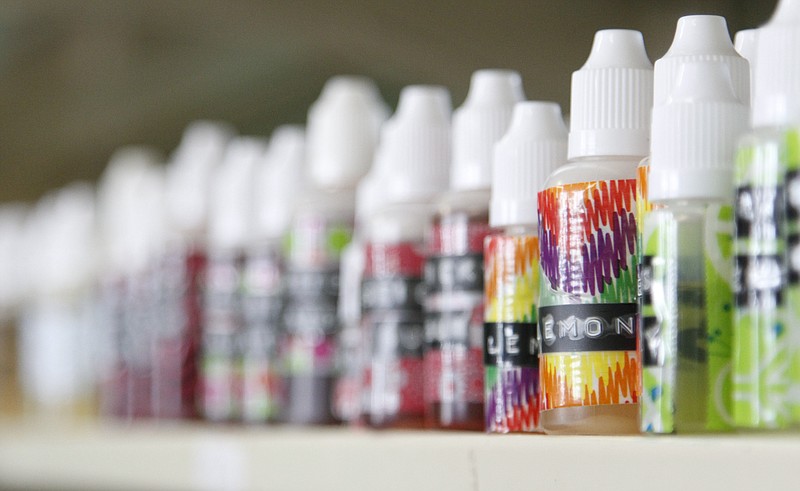The federal government has issued a new warning that e-cigarette products designed to look like popular candy, cookies and juice boxes pose a threat to children.
Even in small amounts, nicotine can cause seizure, coma, respiratory arrest and death from cardiac arrest in children if they touch or drink it.
Safety tips
› Follow storage tips for e-liquids and teach children to avoid these products› Remember that children are curious and put all sorts of things in their mouths. Even if you turn away for a few seconds, they can quickly get into things that could harm them.› You can help prevent accidental exposure to e-liquids by always putting your e-cigarettes and/or e-liquids up and away — and out of kids’ and pets’ reach and sight — every time you use them.› Also ask family members, house guests, and other visitors who vape to keep bags or coats that hold e-cigarettes or e-liquids up and away and out of reach and sight of children and pets.› For children old enough to understand, explain to them that these products can be dangerous and shouldn’t be touched. And tell kids that you or another adult are the only people who should handle these products.Handle with care› When you remove products from their storage locations, it’s important to handle them in a way that may help to prevent kids’ exposure to e-liquids.› Store e-liquids in their original containers, so others know exactly what they are. This will help children know to avoid these products.› Make sure product caps are locked when you’re not using them, and relock caps when you’re finished. If a bottle has a cap that turns, twist it until you cannot twist anymore.› Avoid contact with your skin and eyes when you use these products. E-liquid exposure can cause burning and irritation, among other problems. In case of accidental contact with skin or eyes, wash the area thoroughly with soap and water.› Clean up any spills or splashes immediately using soap and water.› Neve drink e-liquid, or allow anyone to drink it, because the liquid nicotine can be poisonous. If a child accidentally drinks e-liquid, immediately call Poison Control at 1-800-222-1222. Also call this number if you think a child has been exposed to these products — even if you’re not completely sure.Source: FDA
Between 2012 and 2017, the National Poison Data System received 8,269 calls related to liquid nicotine exposure in children younger than 6, mostly from drinking the substance. The system did not release information on fatalities.
"These are preventable accidents that have the potential to result in serious harm or even death," Scott Gottlieb, commissioner of the U.S. Food and Drug Administration, said in a statement last week. The FDA regulates tobacco products, including e-cigs, cigars, cigarettes, smokeless tobacco, hookah and pipe tobacco.
Although all liquid nicotine poses a threat, ones that taste good or are made to look like food are especially worrisome.
Last week, the Federal Trade Commission, which is tasked with preventing unfair or deceptive advertising, joined the FDA in issuing warning letters to manufacturers and retailers for selling e-liquids with labeling that resembles kid-friendly products, such as juice boxes or candy.
Several of the companies receiving warning letters also were cited for illegally selling the products to minors.
"No child should be using any tobacco product, and no tobacco products should be marketed in a way that endangers kids - especially by using imagery that misleads them into thinking the products are things they'd eat or drink," Gottlieb said.
E-cigarettes, also called "vapes," are designed to deliver vaporized liquid nicotine and are gaining favor over "combustible tobacco," or cigarettes, for those who view vaping as safer than smoking. And while research on the longterm effects of e-cigarettes is limited, experts agree that the industry aims to entice young people.
Gottlieb has focused attention recently on vaping among teenagers, which he called "a cult fad" during an interview Monday with National Public Radio.
"We don't know if we're at the tail end of popularity or this is going to continue and we're going to see a whole bunch of young people become addicted," he said.
Child and teen use is especially concerning, since evidence suggests youth exposure to nicotine affects the developing brain and could make it more susceptible to addiction in the future, according to a joint statement from the FDA and FTC.
Gaylord Lopez, director of the Georgia Poison Center, said the agency began tracking calls for liquid nicotine exposure in 2011, when it recorded five cases. By 2015, that number peaked at 121 before falling to 61 in 2017.
A spokesperson for the Tennessee Poison Center said Monday the agency was unable to release call data related to nicotine exposure.
But as more, younger vapers emerge, they may be less attuned to keeping e-cig products away from kids, Lopez said.
"It doesn't matter where the use comes from," he said. "These cases that we had at its height were mainly from the parents' lack of being safe in the home, but certainly a sibling is quite problematic."
While nicotine concentration in e-liquids varies, the negative effects of toxicity in kids typically start at the nicotine equivalent of one to two cigarettes, with the biggest danger being when they ingest large amounts for their body weight.
"You always need to be on the lookout," Lopez said. "You just don't want your kid to be a statistic."
Contact staff writer Elizabeth Fite at efite@timesfreepress.com or 423-757-6673.
